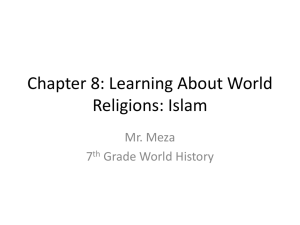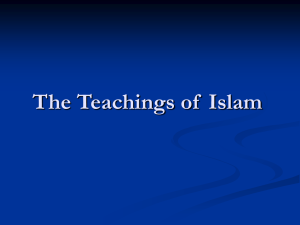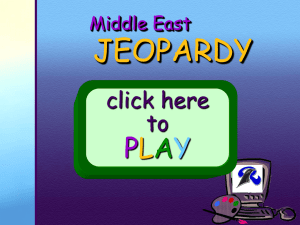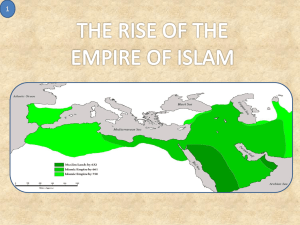Lesson 9 The Teachings of Islam
advertisement
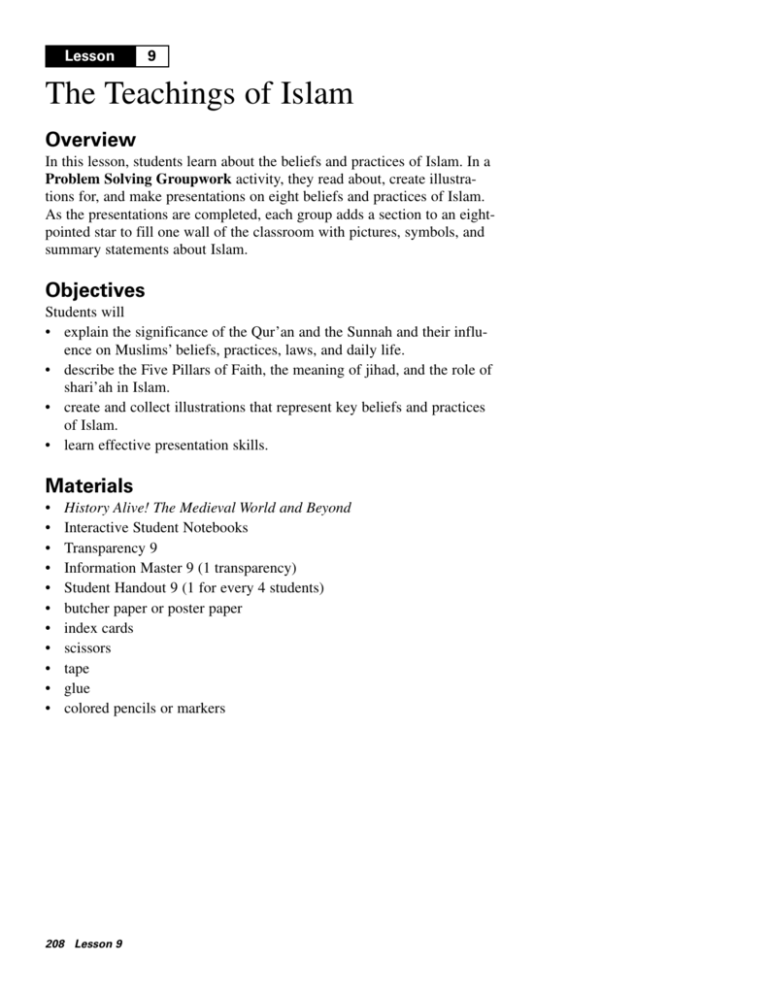
Lesson 9 The Teachings of Islam Overview In this lesson, students learn about the beliefs and practices of Islam. In a Problem Solving Groupwork activity, they read about, create illustrations for, and make presentations on eight beliefs and practices of Islam. As the presentations are completed, each group adds a section to an eightpointed star to fill one wall of the classroom with pictures, symbols, and summary statements about Islam. Objectives Students will • explain the significance of the Qur’an and the Sunnah and their influence on Muslims’ beliefs, practices, laws, and daily life. • describe the Five Pillars of Faith, the meaning of jihad, and the role of shari’ah in Islam. • create and collect illustrations that represent key beliefs and practices of Islam. • learn effective presentation skills. Materials • • • • • • • • • • • History Alive! The Medieval World and Beyond Interactive Student Notebooks Transparency 9 Information Master 9 (1 transparency) Student Handout 9 (1 for every 4 students) butcher paper or poster paper index cards scissors tape glue colored pencils or markers 208 Lesson 9 Lesson 9 Preview Project Transparency 9: Islamic Beliefs and Practices and have students refer to it as they complete Preview 9 in their Interactive Student Notebooks. Allow them to share some of their questions. For example, they might ask, Why are these men sitting on the sidewalk? (They are preparing to pray; people often stop their daily activities to pray wherever they are.) Or, Why are all these people walking around in a circle? (This ritual is one way Muslims honor God.) Then explain that these images illustrate aspects of Islamic beliefs, practices, laws, and daily life that students will learn about in this lesson. During this lesson, students will likely discover answers to their questions. Graphic Organizer 1 Introduce Chapter 9 in History Alive! The Medieval World and Beyond. Have students read Section 9.1. Make sure they understand the meanings of the boldfaced key terms, which are defined in the Glossary. Explain that in this chapter they will learn about the teachings of Islam and how they influenced the people living under Muslim rule in medieval times and today. (Note: You may want to have students use the Prereading Handout in this Lesson Guide to conduct a prereading of the chapter.) 2 Introduce the graphic organizer. Have students examine the illustration on page 93. Ask, What do you see? What might the various terms on the star mean? Why might a star be a common feature in Islamic art? Tell students that stars are used often in Islamic art because the Qur’an discourages the depiction of human or animal figures (worship of human and animal idols was a common practice among polytheists in Muhammad’s time). As a result, Muslim artists developed the use of geometric shapes into an art form. The star is a geometric shape that radiates from a central point, an appropriate symbol for a religion that emphasizes the centrality of one God, toward whom all Muslims turn. Each of the eight sections of this star represents a key belief or practice of Islam. Reading for Understanding Have students read Section 9.2, which provides background information on Islam. When students have completed the reading, ask, Where are Muslims found in the world today? What does Islam share with Judaism and Christianity? How is Islam different from Judaism and Christianity? The Teachings of Islam 209 Lesson 9 Problem Solving Groupwork 1 Arrange students in mixed-ability groups of four. You may want to prepare a transparency that shows them with whom they will work and where they will sit. 2 Introduce the activity. Tell students that they will work in groups to create a visual presentation on one of eight key beliefs and practices of Islam. Their visuals will become part of a large, star-shaped poster representing the eight beliefs and practices of Islam they will study. 3 Distribute materials. Give each group Student Handout 9: Creating a Presentation on Islamic Beliefs and Practices, four index cards, a large sheet of poster board or butcher paper, and scissors, glue, and colored pencils or markers. (Note: You may also want to collect images related to Islam from library and Internet sources before beginning this activity. Providing photocopies of pages from books, printouts from the Internet, and other materials will reduce research time and may enhance the end product.) 4 Assign roles and review the steps for creating visuals about Islam. Review Student Handout 9 with the class, and assign each student a role: Writing Supervisor, Research Coordinator, Production Supervisor, or Presentation Supervisor. Assign each group one of Sections 9.3 to 9.10 in History Alive! The Medieval World and Beyond. Explain that, for the topic they read about, each group will create visuals for one section of an eightpointed illustrated star and prepare a presentation. Tell students they will each be responsible for leading the group through one step in preparing the visuals and the presentation. Then review the steps on Student Handout 9. 5 Monitor groups as they create their visuals and presentations. Allow students adequate time to complete their visuals. Check their work and initial Student Handout 9 as they complete each step. (Note: For Step 3 on the handout, you may want to offer students the option of creating their presentations on transparencies or using presentation software.) When groups reach Step 5 on the handout, project Information Master 9: Eight-Pointed Star onto a wall. Have volunteers from each group come up to trace a section of the star. Assign each group a different color for outlining their section of the star. (Note: All sections are the same, so it does not matter which they trace, but groups do need to know how their section will be oriented on the final star. Alternatively, you may want to trace the sections yourself before the activity begins.) 6 Conduct the presentations and quiz game. Have one group post their star section and summary on the wall and make their presentation. Praise students for meeting the criteria on Student Handout 9. Make sure students in the audience take notes in the appropriate section of their 210 Lesson 9 Lesson 9 Reading Notes during each presentation. Collect the quiz questions from the presenting group, and conduct a quiz game as follows: • Assign all members in each group a letter: A, B, C, or D. • Randomly choose one of the four letters, and have students with that letter stand up. • Select one quiz question written by the presenting group, and read it to these “contestants.” (Note: Depending on the time available, you may want to ask more than one question.) • Have contestants write their answers in large print on scrap paper. • Have contestants hold up their answers simultaneously. Award points to groups accordingly. 7 Debrief the activity. Ask, What aspects of Islam do you think you will most remember from this activity? For those of you who did not know much about Islam before this activity, how is Islam like what you thought before? Unlike what you thought? Why might Islam be a unifying force in medieval times? Today? Processing Have students complete Processing 9 in their Interactive Student Notebooks. The Teachings of Islam 211 Lesson 9 Assessment 1. A 6. C Masters for assessment appear on the next three pages. 4. B 5. B 3. C 2. A 7. C 8. C 9. 1. f 2. a 3. h 4. c 5. e 6. d 7. i 10. The bulleted points can provide a rubric for this item. Online Resources Further resources for Lesson 9: The Teachings of Islam can be found at Online Resources for History Alive! The Medieval World and Beyond at www.teachtci.com/historyalive/. • Unit 2 Internet Connections: The Rise of Islam • Unit 2 Internet Project: The Rise of Islam Options for Students with Diverse Needs See page 446 for tips on adapting this lesson to meet the needs of • English language learners. • learners reading and writing below grade level. • learners with special education needs. • advanced learners. 212 Lesson 9 Assessment 9 Fill in the bubble beside the best answer to each question. 1. What does the list below reveal about Islam? • Muslims pray five times a day. • Muslim women dress modestly. • Muslims don’t drink alcohol or eat pork. • Muslims give money to support charities. 0 A. Islam is a way of life. 0 B. Islam was popular in Arabia in the 700s. 0 C. Islam was the same as other religions. 0 D. Islam is a religion of hardship. 2. According to Islam, Jews and Christians are “People of the Book.” What does this mean? 0 A. These religions are guided by holy writings that came from God. 0 B. These religions believe in storytelling. 0 C. These religions inspire people to read the same books. 0 D. These religions worship in similar ways. 3. Which of the following is true of the Qur’an, but not true of the Sunnah? 0 A. It is recorded as the hadith, or tradition. 0 B. It contains examples for living that Muhammad set during his lifetime. 0 C. It was written with the help of the angel Gabriel. 0 D. It is followed by Jews and Christians. 5. For Muslims, praying five times a day is a way of life that emphasizes spirituality and 0 A. hard work. 0 B. discipline. 0 C. fairness. 0 D. kindness. 6. The word zakat means “purification.” According to Islam’s Third Pillar of Faith, sharing one’s money or possessions with the needy makes wealth pure. Why is that? 0 A. It encourages belief in one God. 0 B. It encourages belief in luck. 0 C. It discourages greed. 0 D. It discourages work. 7. Which of the following is one of the Five Pillars of Islam? 0 A. shari’ah 0 B. struggle 0 C. pilgrimage 0 D. Sunnah 8. Jihad means “to strive.” What are Muslims striving for? 0 A. to influence others 0 B. to succeed in business 0 C. to overcome challenges 0 D. to attract followers 4. According to the first Pillar of Faith, 0 A. Muslims pledge to pray every day. 0 B. Muslims pledge to submit to God. 0 C. Muslims pledge to fast during Ramadan. 0 D. Muslims pledge to travel to Makkah. © Teachers’ Curriculum Institute The Teachings of Islam 213 Assessment 9 Use your knowledge of social studies to complete the item below. 9. Match each term on the left with the correct definition on the right. (Notice that there are a few extra choices on the right.) 1. the First Pillar of Faith a. ritual prayer 2. the Second Pillar of Faith b. holy book 3. the Third Pillar of Faith c. fasting 4. the Fourth Pillar of Faith d. struggle 5. the Fifth Pillar of Faith e. pilgrimage 6. jihad f. belief in God 7. shari’ah g. leader h. almsgiving i. law j. judgment 214 Lesson 9 © Teachers’ Curriculum Institute Assessment 9 Follow the directions to complete the item below. 10. Pretend you are a textbook publisher who is planning to use these five images in a new social studies textbook. Write a caption for each image. Your captions should include the following: • information about what is shown in the image. • information about what Muslim belief or practice the image relates to. © Teachers’ Curriculum Institute The Teachings of Islam 215 Student Handout 9 Creating a Presentation on Islamic Beliefs and Practices Work with your group to create a visual and a presentation on an Islamic belief or practice. ____ Step 1: Review the roles. Your teacher will assign you a role. With your group, read the information below. Make sure everyone understands his or her responsibilities. Writing Supervisor: You will lead the group during Step 3 when your group is developing a presentation outline. You will write the presentation outline, help prepare the visuals, and be involved in the presentation. You will also write one quiz question. Research Coordinator: You will lead the group during Step 4 when your group is collecting and creating visuals for the star. You will assist with the presentation outline and the presentation. You will also write one quiz question. Production Supervisor: You will lead the group during Step 5 as your group assembles visuals for your presentation. You will help with the presentation outline and be involved in the presentation. You will also write one quiz question. Presentation Supervisor: You will lead the group during Step 7 as your group prepares the presentation. You will help with the presentation outline and the preparation of visuals and be involved in the presentation. You will also write one quiz question. ____ Step 2: Learn about the Islamic belief or practice assigned to you. Follow the directions in your Interactive Student Notebook for your assigned reading section. After you are done reading, the Research Coordinator should make sure everyone has recorded accurate answers to the questions in the corresponding section of the Reading Notes. ____ Step 3: Create a presentation outline. The Writing Supervisor should use the answers to the Reading Notes questions to create an outline for the presentation on a large sheet of paper. All other group members should move on to Step 4. The presentation outline should include • the Arabic term at the top in big, bold letters. • a definition for the Arabic term. • four summary statements that answer the questions from your Reading Notes. Number the statements to correspond with the questions. The statements should be free of grammatical errors and misspellings and be large enough to be read from the back of the room. 216 Lesson 9 © Teachers’ Curriculum Institute Creating a Presentation on Islamic Beliefs and Practices Student Handout 9 ____ Step 4: Collect and create visuals that match your assigned belief or practice. The Research Coordinator should lead the effort to collect at least three or four visuals for illustrating your group’s section of the star. Group members should draw, trace, photocopy, or download and print visuals that illustrate the topic. All images should demonstrate sensitivity toward Islamic beliefs and practices and cannot show Muhammad, Gabriel, or Allah. Use your school’s library and Internet services as resources. With your teacher’s permission, you may also use words as illustrations, as long as they are decorative as well as functional (use calligraphy, special fonts, and color to achieve this). ____ Step 5: Assemble the visuals for your presentation. The Production Supervisor should lead the group as it assembles the visuals for your group’s presentation. Follow these steps: • Trace one section of the projected star onto a sheet of butcher or poster paper. (Your teacher may have already done this for you.) • Outline the section of the star in your assigned color. • Paste or draw your visuals into the outlined section. ____ Step 6: Write four quiz questions for the audience to answer after your presentation. Each group member is responsible for writing one quiz question on an index card or separate piece of paper. Make sure your questions relate to the content covered in your presentation. ____ Step 7: Practice your presentation. The Presentation Supervisor should lead the group as it prepares to present. He or she should assign each group member at least one part of the presentation outline and, if possible, one visual to share with the class. The Presentation Supervisor should also decide the best order for the presentation and remind group members of these presentation tips: • Good presenters engage the audience by making eye contact with people in all areas of the room. • Good presenters show enthusiasm by gesturing and changing the position of their bodies. • Good presenters prevent boredom by altering the pitch and tone of their voices. • Good presenters impress the audience by showing strong knowledge of the subject and saying interesting things about it. © Teachers’ Curriculum Institute The Teachings of Islam 217 Information Master 218 Lesson 9 9 Eight-Pointed Star © Teachers’ Curriculum Institute GUIDE TO READING NOTES 9 Read your assigned section of History Alive! The Medieval World and Beyond. Answer the questions for that section. You will take notes for the other sections during the class presentations. 9.3 The Qur’an and the Sunnah 1. What is the difference between the Qur’an and the Sunnah? The Qur’an is Islam’s sacred book and is considered to be the words of God. The Sunnah is the example set by Muhammad. 2. How is the Qur’an related to the Christian Bible and the Jewish Torah? (See Section 9.2 for more information.) Several of the figures in the Torah and the Bible are also found in the Qur’an. The Qur’an states that God “earlier revealed the Torah and the Gospel as a source of guidance.” 3. How do Muslims show their reverence for the Qur’an? They do not let the book touch the ground or get dirty. Most Muslims memorize all or part of the Qur’an. 4. How are hadith related to the Sunnah? The Sunnah are Muhammad’s actual words and deeds. Hadith are a written record of the Sunnah. 9.4 The First Pillar: Shahadah (Profession of Faith) 1. What phrase do Muslims repeat as an expression of shahadah? “There is no god but God, and Muhammad is the messenger of God.” 2. According to Muslims, who is Allah? Allah is the one, all-powerful God who created the universe. 3. How does Allah relate to the God of Christians and Jews? (See Section 9.2 for more information.) Muslims believe that all three of these religions worship the same God. 4. What do Muslims believe about angels and judgment? Muslims believe that angels do Allah’s work throughout the universe. They believe that everyone will face God’s judgment; some will go to paradise, others to hell. 220 Lesson 9 5. In the star, make a sketch to illustrate this section. Sketches will vary. 5. In the star, make a sketch to illustrate this section. Sketches will vary. GUIDE TO READING NOTES 9 9.5 The Second Pillar: Salat (Daily Worship) 1. Where and how often do Muslims pray? Muslims pray five times a day, wherever they are. 5. In the star, make a sketch to illustrate this section. Sketches will vary. 2. Toward what city do Muslims pray? Muslims pray toward Makkah. 3. What are Muslims required to do before they pray? They must perform ritual washings of their hands, face, arms, and feet. 4. What do beads, rugs, mosques, the qibla, muezzins, and imams have to do with worship? Prayer beads are used in reciting God’s characteristics, rugs are for kneeling on, mosques are where Muslims gather to worship, the qibla is the direction of Makkah, muezzins call others to prayer, and imams are prayer leaders. 9.6 The Third Pillar: Zakat (Almsgiving) 1. Why is charitable giving important to Muslims? Muslims believe that wealth is purified by giving some of it away, that sharing helps control greed, and that giving reminds people of God’s gifts. 5. In the star, make a sketch to illustrate this section. Sketches will vary. 2. How much of their wealth do Muslims give? They give about one fortieth of their surplus wealth and possessions. 3. What kinds of things does zakat pay for? Zakat pays for orphanages, hospitals, soup kitchens, and clothing and shelter for the poor. It pays debts for the poor and helps stranded travelers. 4. Are Muslims the only religious group that emphasizes giving? Explain your answer. No; Jews and Christians, for example, also believe in giving a portion of their wealth to support others. The Teachings of Islam 221 GUIDE TO READING NOTES 9 9.7 The Fourth Pillar: Siyam (Fasting) 1. What is siyam? When is it performed? Siyam is daily fasting. It is performed from sunrise to sunset during Ramadan, the ninth month of the Islamic lunar calendar. 2. What rule about food do Muslims observe during Ramadan? Muslims do not eat or drink between sunrise and sunset. 5. In the star, make a sketch to illustrate this section. Sketches will vary. 3. How do Muslims break their fast during Ramadan? How is the end of Ramadan celebrated? Muslims break the daily fast at sunset, with dates and other food and drink. The end of Ramadan is celebrated with prayers, special foods, an exchange of gifts, and giving to the poor. 4. What does Ramadan encourage? Ramadan encourages generosity, equality, and charity. Muslims are also encouraged to avoid arguments and bad deeds, to give thanks, and to forgive people. 9.8 The Fifth Pillar: Hajj (Pilgrimage) 1. What values does the hajj promote? The hajj promotes fellowship and equality. 5. In the star, make a sketch to illustrate this section. Sketches will vary. 2. How do Muslims dress for the hajj? They wear simple white clothing. 3. What is the Ka’ba? The Ka’ba is a shrine built by Abraham to honor God. 4. What other important sites do Muslims visit during the hajj? They travel along a passage between two small hills, as Hagar did when she searched for water. They camp in tents at Mina, pray at the plain of Arafat, and some climb Mount Arafat. Before leaving Makkah, they circle the Ka’ba seven more times. 222 Lesson 9 GUIDE TO READING NOTES 9 9.9 Jihad (Struggle) 1. How does jihad relate to Muslims and their personal struggles? Jihad gives Muslims a way to respond positively to external and internal challenges. 5. In the star, make a sketch to illustrate this section. Sketches will vary. 2. What is the “lesser jihad”? The “lesser jihad” relates to the external struggle against oppression, the outer battle. 3. What is the “greater jihad”? The “greater jihad” is the fight against evil within oneself. 4. What standards did the Qur’an and Muhammad set for Muslims’ conduct during war? The Qur’an and Muhammad say that Muslims should honor agreements made with enemies and that they should not mutilate the dead, harm innocents, or destroy property, orchards, crops, sacred objects, or houses of worship. 9.10 Shari’ah: Islamic Law 1. What is shari’ah, and how did it develop? Shari’ah is the body of Islamic law based on the Qur’an and the Sunnah. It guides Muslims in their personal behavior. It was developed by caliphs and scholars who used the Qur’an and the Sunnah to solve problems that arose. 2. What values does shari’ah promote? It promotes obedience to the Qur’an and respect for others. 5. In the star, make a sketch to illustrate this section. Sketches will vary. 3. What are three examples of behaviors that shari’ah regulates? Muslims may not eat pork, drink alcohol, or gamble. They must dress modestly. 4. How has shari’ah changed over the years? Western codes of law have replaced or supplemented shari’ah in many Muslim countries. Shari’ah continues to develop in response to modern ways of life. The Teachings of Islam 223
